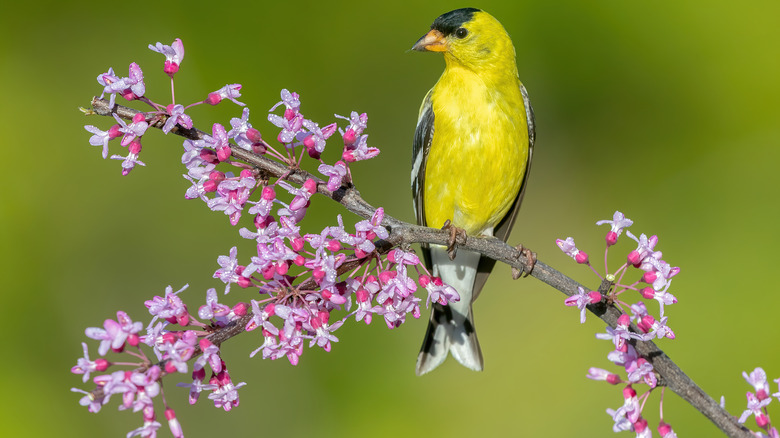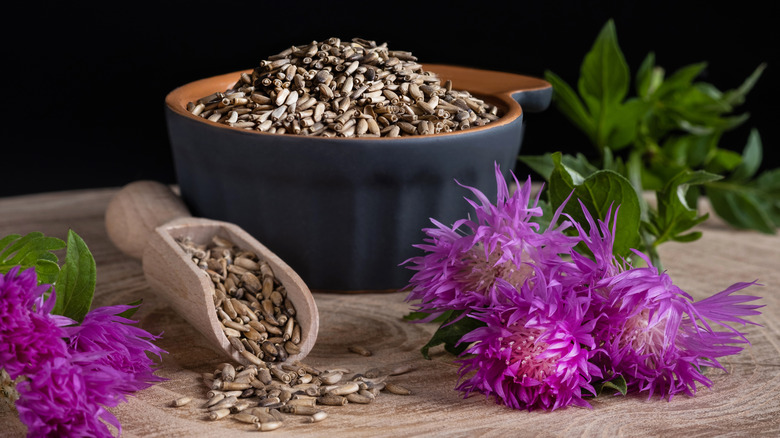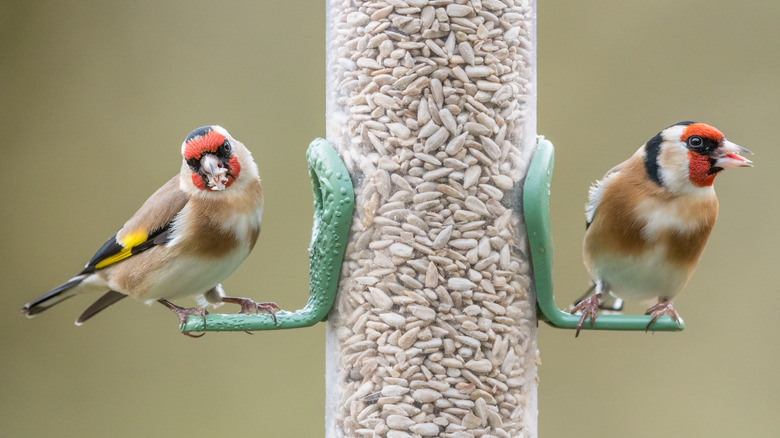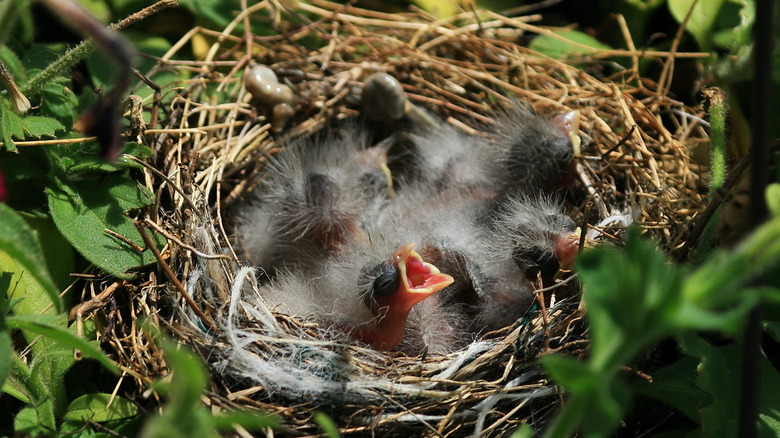How To Attract Finches To Your Garden
Finches live in almost every continent and the brilliantly hued bird is a welcome visitor at many a garden. According to Wild Bird World, the 234 species of the family Fringillidae are recognized as the "true" finches. Weighing almost an ounce, the songbird can reach 4 inches from cone-shaped beak to tail. Finch varieties are the official bird of four U.S. states (Iowa, New Hampshire, New Jersey, and Washington) and are popular house pets, per Insider.
Transforming your garden into a safe haven will be a magnet for these birds. Providing finch-appropriate food, ample water, and suitable nesting supplies are keys to attracting these colorful creatures. Finches are actually ill-suited to indoor life. They do not like to be touched. They prefer feathered companions and congregate in large flocks. Finch owners tend to use small cages, but the little birds actually need large spaces in which to fly and thrive. Therefore, attracting finches to one's garden is the best option for finch fans and finches alike. Most varieties do not migrate, so a bird lover can enjoy their company all year around.
Fresh food will attract finches
Providing plentiful and proper food will draw finches to your garden. Finches are choosy, and the birds have certain standards when it comes to their diet and eating habits. Black seeds that are fresh and high in fat are most desirable. Sunflower seeds are another good choice, according to More Birds. However, those also attract other birds such as blue jays, a thorn in the side of finches. Seeds that their small beaks can handle work best for finches.
Thistle seeds are a favorite. Make sure they are fresh; a finch will reject dry or stale food. Fresh seeds will leak oil when squeezed, and they can be frozen or refrigerated to prolong freshness. Keep them dry and not clumpy. Nyjer seeds, a sunflower relative derived from the African yellow daisy, are also prized by finches. High in oil and protein, they are a winter staple, as noted by Flocking Around.
Having seed-producing plants in your garden is another surefire way to attract finches. Cattails and cottonwood plants appeal to the birds, and they will seek out your dandelions for their seeds. Birds & Blooms warns that finches can be caught in burrs of the burdock plant when feeding, so don't have them in your garden. In any case, provide an adequate supply of fresh seeds, especially during the winter months.
Finches will come to proper feeders
Equally important as seeds for attracting finches are the proper bird feeders. Finches can cling to mesh, sock-style feeders, making it easy for them to extract the seeds within. Multiple finches can eat at the same time, an attraction for the sociable birds. Tube feeders will thwart larger and more aggressive nemeses, according to World Birds, and you can add perching sticks for group eating. The tiny holes of specialized Nyjer seed feeders provide finch access but also block bigger birds. Finches are skittish, so don't place feeders out in the open if you want birds to come. You can gradually move and expose the feeder more as birds get accustomed to it. Surrounding it with a colorful ribbon might trick a finch into thinking another bird is safely at the feeder, and having colorful plants nearby might attract it in the first place. A brightly colored garden will catch the attention of airborne finches.
Keeping seeds fresh is essential to attracting your feathered friends, so be sure to clean the feeder daily. Remove stale seeds and weather-guard feeder to keep seeds pristine. Seeds will stay fresher if your feeder allows air to circulate. Finches generally do not finish their food and typically will leave your feeder half full.
A garden that attracts finches will have a bird bath or other water supply. Finches are fastidious and won't mix drinking and bathing, so replace water frequently.
Welcome a finch nest in your garden
A backyard deemed suitable for a nest will be attractive to finches, while an enclosed birdhouse might serve as an adequate nesting place for your backyard visitors. A field with seed-producing weeds surrounded by low, thick shrubs would be an ideal location (Birds & Blooms).
The birds are drawn to shrubs with forks where multiple branches meet. They will select this axis as a perfect place to cradle a nest. Nests are constructed by female finches using thistles, briars, and available weeds, according to Best Farm Animals. Finch nests are cup-shaped. They are often lined with thistle down, leaves, grass, or feathers, per Sciencing, and these supplies are gathered by the male birds. Leaving those items for wayward finches might encourage them to stay in your garden, or at least stop by for a quick bite. Nest construction is apt to occur comparatively late in the season while finches allow thistles to ripen.



